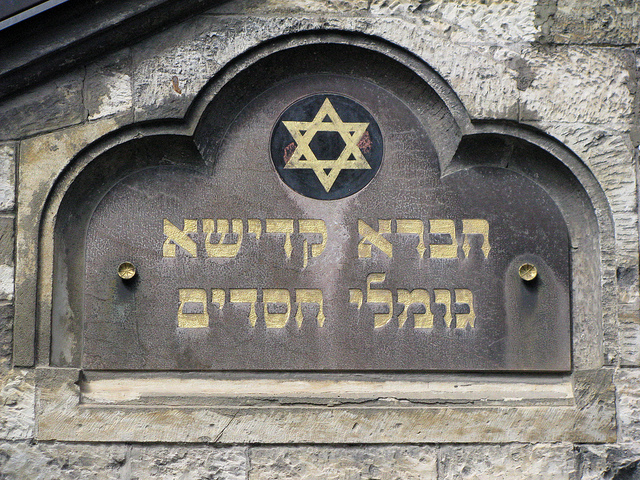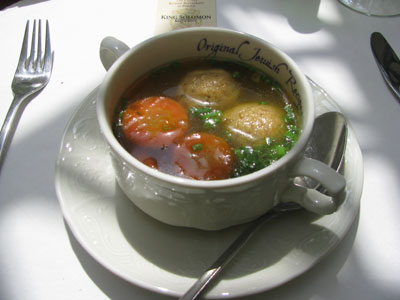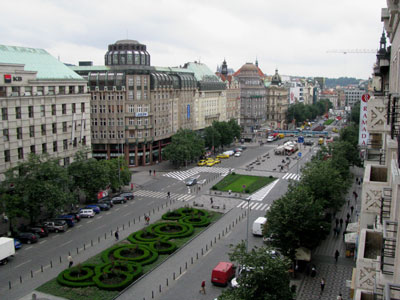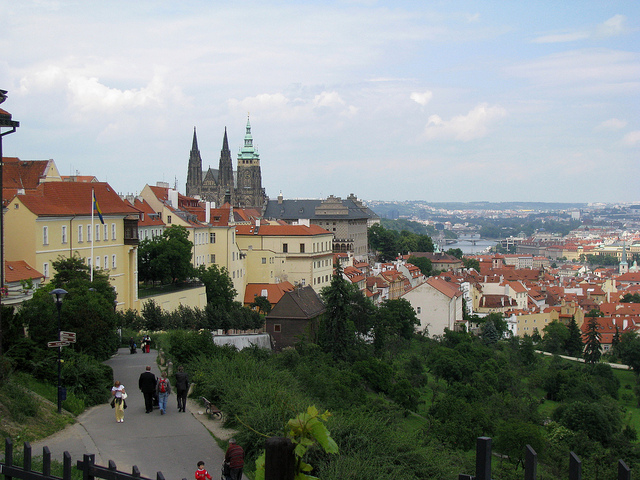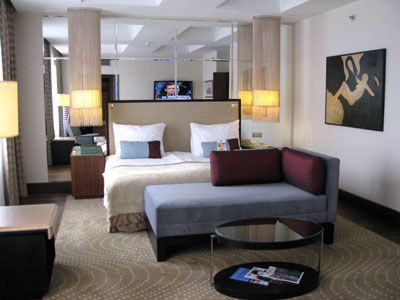Surrounding it is the Museum of Fine Arts, and a department of Charles University, one of Europe’s oldest universities. A few steps away we stopped at the tall walls of the Jewish Cemetery where there is a small square window that allows you a little peak into the cemetery. Richard indicated that the entire cemetery had to be enclosed by walls and there are very few places where you can catch a glimpse of the cemetery. This little peephole is one of them.

The peephole into the Jewish Cemetery
The Jewish Cemetery of Prague was founded in 1478 and held burials until 1787. In some cases people had to be buried on top of one another, up to twelve layers deep. In excess of 100,000 people are estimated to have been buried here. More than 12,000 gravestones can still be seen; most of them are difficult to read and they are densely packed on the small plot of land.

Gravestones in Prague’s Jewish Cemetery
After a walk around the cemetery’s perimeter walls we arrived at the Klausen Synagogue which was completed in 1694. This High Baroque structure today houses Hebrew prints and manuscripts and an exhibition of Jewish traditions and customs. The building right next to it is the Ceremonial Hall of the Jewish Burial Society, built in 1906. Richard explained that in the Jewish religion, burials have to take place no later than one day after death. Naturally, the people handling the burials had to be located very close to the cemeteries. A wrought-iron fence between the two buildings allowed for another peek into the Jewish Cemetery.

The Klausen Synagogue in Prague’s Jewish Quarter
My guide explained that for about $15 you gain access to the Jewish Museum which includes admission to five difference Jewish locations. Souvenir shops line the street beside the cemetery, many of them selling figures of the legendary Golem. Towards the end of this street is the Old-New Synagogue, with its construction date of 1270 the oldest synagogue in all of Europe. This Gothic building has often granted refuge to Jews over the centuries and is still the religious centre for Prague’s Jewish community. Rabbi Löw’s chair is an authentic relic used by the 16th century scholar.

The Old-New Synagogue, Europe’s oldest synagogue
Religious services have been held every Friday and Saturday at the Old-New Synagogue for more than 700 years. Just south of the Old-New Synagogue is the Jewish Town Hall, built between 1570 and 1577 by Jewish mayor Mordecai Maisel. This meeting hall is still the location of dinners, get-togethers and festivals. Richard pointed out the clock faces on the building: the upper clock face in the tower uses Roman numerals, while the lower clock face on the building’s façade uses Hebrew numerals. The hands of this clock also move in an anti-clockwise direction as Hebrew is read from right to left.

The Jewish Town Hall with its Roman and Hebrew clockfaces
In addition to these historic Jewish buildings I was amazed by the outstanding Art Nouveau architecture. Virtually all the buildings feature extensive Art Nouveau decorations and some also have Cubist details. Richard explained that the Jewish Quarter has become Prague’s most desirable neighbourhood because of its central location and spacious apartments.

Outstanding Art Nouveau architecture in Prague’s Jewish Quarter
The High Synagogue is just a few steps south of the Old-New Synagogue and after a short walk we reached one more Jewish prayer house: the Spanish Synagogue was built in the location of the Old School, Prague’s first synagogue, and today is a Reform synagogue. It was built in 1868 in the Moorish Revival Style and is the most elaborate of Prague’s synagogue buildings. Intricate stucco details on the walls are reminiscent of the Alhambra in Spain. A poster outside illustrated the richly decorated interior of the Spanish Synagogue, referring to it as “the most beautiful synagogue in Europe”.

Prague’s Spanish Synagogue
Immediately next to the Spanish Synagogue is a mysterious statue of Franz Kafka: an oversize male metal figure in a black suit without a head that has a smaller man dressed in a suit sitting on its shoulder. The diminutive man on top is Franz Kafka. This bronze sculpture was created by Czech sculptor Jaroslav Rona and was unveiled in 2003.

The mysterious Franz Kafka sculpture
After this extensive introduction to Jewish history in Prague it was early afternoon and it was definitely time to have lunch. Richard and I headed into another Jewish institution in Prague’s Jewish Quarter, the King Solomon Restaurant on Siroka Street, to explore real kosher food. By this time my stomach was growling and I was really looking forward to exploring Prague’s Jewish delicacies.

Interesting architectural details in Prague’s Jewish Quarter
sivaorasad
Related Videos:
The famous Astronomical Clock is ringing
Starting our tour of the Jewish Quarter
Franz Kafka’s birth house
Amazing Art Nouveau Architecture in Prague’s Jewish Quarter
The Rudolfinum Concert Hall
Tiny window opening up into the Jewish Cemetery
The Klausen Synagogue
The Jewish Town Hall and the Old-New Synagogue
Art Nouveau villa beside the Old-New Synagogue
The splendid Spanish Synagogue
Mysterious sculpture of Franz Kafka beside the Spanish Synagogue
